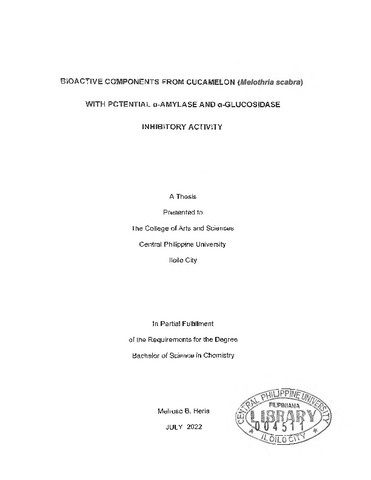Bioactive components from cucamelon (Melothria scabra) with potential α-amylase and α-glucosidase inhibitory activity
摘要
Cucamelons (Melothria scabra) are found growing in the wild in the Philippines. The lack of available literature regarding the plant species prompted to conduct of this study. This study aimed to extract and fractionate bioactive components from cucamelon with potential α-amylase and α-glucosidase inhibitory activity. Cucamelon fruit samples were obtained from Brgy. Pagsanga-an Pavia, Iloilo, extracted with methanol, fractionated using silica column chromatography, and assayed for α-amylase and α-glucosidase inhibitory activity. Results show that most but not all of the fractions have α-amylase inhibitory activity. Only four fractions showed α-amylase activity, namely, acetone (8.97 ± 1.54), acetone: methanol, 4:1 (15.54 ± 2.12), acetone: methanol, 3:2 (11.30 ± 2.51), and acetone: methanol, 1:4 (17.94 ± 2.19). Only one fraction had α-glucosidase inhibitory activity, which is acetone: methanol, 3:2 (3.59 ± 1.10). Cucamelon has a low inhibitory activity for α-amylase and α-glucosidase, enzyme markers of diabetes, which can be compensated by increasing the daily intake. It is recommended that unripe cucamelon fruits can be eaten regularly as salads, or pickled to help prevent the risk of developing diabetes.
描述
Abstract only
建议引文
Heria, M. B. (2022). Bioactive components from cucamelon (Melothria scabra) with potential α-amylase and α-glucosidase inhibitory activity (Unpublished thesis). Central Philippine University, Jaro, Iloilo City.
文件类型
Thesis部
College of Arts and Sciences学位
Bachelor of Science in Chemistry货架位置
Filipiniana Theses 540.72 H423
物理描述
vii, 40 leaves



